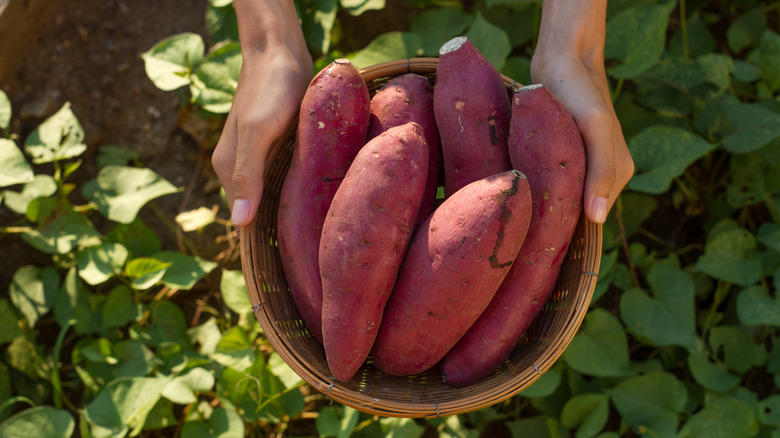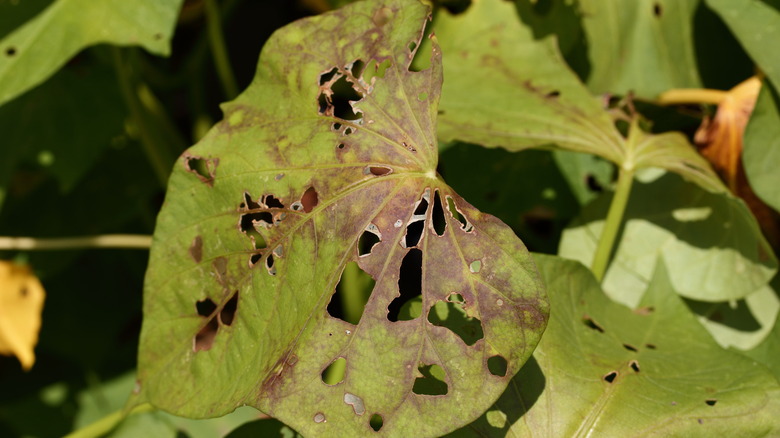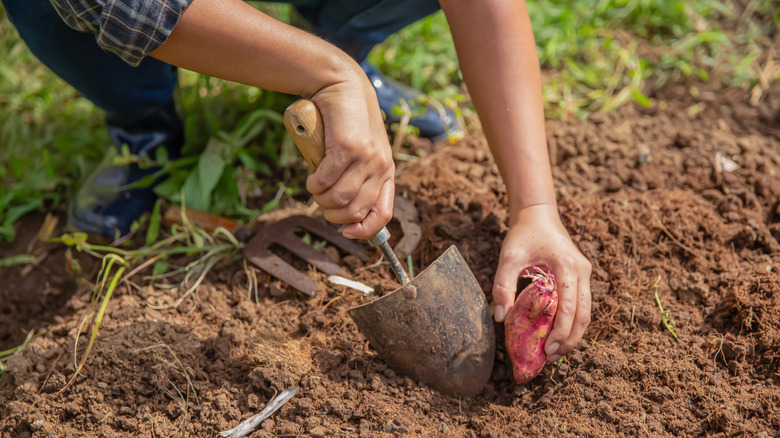The Downsides To Growing Sweet Potatoes In Your Garden
Besides being a versatile and nutritious root crop prized for its sweet flavor, vibrant colors, and health benefits, the sweet potato (Ipomoea batatas) is known for being adaptable to various growing conditions, including different climates and soil types. Additionally, mature sweet potato plants are tolerant of drought, making them suitable even in areas with limited water availability. They're prolific producers, so sweet potatoes can often yield large harvests from relatively small planting areas. These qualities (and more) make sweet potatoes popular among gardeners. However, growing sweet potatoes at home also comes with a set of downsides, such as pest infestations, disease susceptibility, and root problems.
Gardeners often choose to cultivate sweet potatoes in their gardens because they are highly nutritious, they're packed with vitamins, minerals, and fiber, making them a valuable addition to any diet. They are also relatively low-maintenance crops, requiring minimal care once established. If you want to grow sweet potatoes successfully, you need to be aware of typical problems that may arise when you plant them in your garden. By taking a proactive stance in your sweet potato growing project, you can avoid or minimize the stress that may come with planting them.
Common problems when growing sweet potatoes
While sweet potatoes are generally easy to grow, they are not without their challenges. There are some common problems that gardeners typically encounter when cultivating sweet potatoes, not the least of which are pest infestations. Sweet potatoes are susceptible to garden raiders like sweet potato weevils, aphids, whiteflies, wireworms, root-knot nematodes, and white grubs that damage the roots and can reduce yields. To combat these creatures, practice rotating your garden crops, implement strict garden hygiene, use row covers, and apply organic insecticides like diatomaceous earth when necessary.
Sweet potatoes can also be affected by fungal diseases like Fusarium wilt and root rot, black scurf (aka soilstain), internal cork (small brown to black corky spots in the roots), viruses (like the sweet potato virus disease or SPVD, sweet potato feathery mottle virus or SPFMV, and sweet potato chlorotic stunt virus or SPCSV), and bacterial diseases like black rot and bacterial wilt.
While these problems seem overwhelming, there are things that you can do to prevent them. Sow certified disease-resistant sweet potato varieties, practice good garden sanitation (including using clean, sanitized tools), rotate crops, test and amend soil as needed, and avoid overwatering. Sweet potatoes prefer well-drained, sandy loam soil with a slightly acidic pH (preferably between 5.8 and 6.0). Heavy clay soils can inhibit root development and lead to stunted growth or stringy roots. Improve soil drainage by incorporating organic matter and avoid planting them in compacted soils.
Sweet potato plant care and maintenance
To ensure a successful sweet potato harvest, following certain care and maintenance tips greatly helps. Start sweet potato slips indoors 4-6 weeks before the last frost date or purchase them from a reputable nursery. Plant slips in loose, well-drained loamy soil after all danger of frost has passed. Sweet potatoes prefer full sun to partial shade and require consistent moisture, especially during the growing season. Water them deeply once or twice a week (but reduce the frequency as the plants mature), ensuring that the soil remains evenly moist but not waterlogged.
Avoid over-fertilizing sweet potatoes, as excessive nitrogen can promote lush foliage growth at the expense of root development. Use a balanced fertilizer or compost to provide essential nutrients before planting and during the growing season. Harvest sweet potatoes when the foliage begins to yellow and die back, typically around four to five months after planting, depending on the variety. Carefully dig up tubers, taking care not to damage them, and cure them in a warm, humid environment for 10-14 days before storage. By addressing potential challenges proactively and following these tips, you can cultivate sweet potatoes with confidence, and enjoy bountiful harvests of these delicious and nutritious tubers from your garden.


